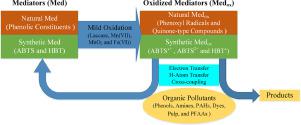Water Research ( IF 11.4 ) Pub Date : 2020-11-23 , DOI: 10.1016/j.watres.2020.116667 Yang Song , Jin Jiang , Wen Qin , Juan Li , Yang Zhou , Yuan Gao

|
Synthetic or natural mediators (Med) can enhance the transformation of different types of organic pollutants by mild oxidants, which has been extensively studied in literature. This enhancing effect is attributed to the following two steps: (i) mild oxidants react with Med forming Medox with higher reactivity, and then (ii) these organic pollutants are more readily transformed by Medox. The present work reviews the latest findings on the formation of Medox from the reactions of synthetic (i.e., 2,2′-azino-bis(3-ethylbenzothiazoline)-6-sulfonate (ABTS) and 1-hydroxybenzotriazole (HBT)) or natural mediators (i.e., syringaldehyde (SA), acetosyringone (AS), p-coumaric acid, and catechol) with mild oxidants such as laccase, manganese oxidants including permanganate (Mn(VII)) and MnO2, and ferrate (Fe(VI)), as well as the transformation of organic pollutants including phenols, amines, polycyclic aromatic hydrocarbons (PAHs), organic dyes, pulp, and perfluoroalkyl acids (PFAAs) by Medox. First, reaction kinetics and mechanisms of the oxidation of synthetic or natural mediators by these mild oxidants were summarized. Reactivity and pathways of synthetic Medox including ABTS·+, ABTS2+, HBT· or natural Medox including phenoxy radicals and quinone-type compounds reacting with different organic pollutants were then discussed. Finally, the possibilities of engineering applications and new perspectives were assessed on the combinations of different types of mild oxidants with synthetic or natural mediators for the treatment of various organic pollutants.
中文翻译:

在合成或天然氧化还原介体存在下,温和氧化剂可增强有机污染物的转化:综述
合成或天然介质(Med)可以通过温和的氧化剂促进不同类型有机污染物的转化,这在文献中已得到广泛研究。这种增强作用归因于以下两个步骤:(i)温和的氧化剂与Med形成高反应活性的Med ox,然后(ii)Med ox更容易转化这些有机污染物。本工作回顾了有关Med ox形成的最新发现来自合成(即2,2'-叠氮基双(3-乙基苯并噻唑啉)-6-磺酸盐(ABTS)和1-羟基苯并三唑(HBT))或天然介质(例如丁二醛(SA),乙酰丁香酮(AS ),对香豆酸和邻苯二酚)与温和的氧化剂(如漆酶),锰氧化剂(包括高锰酸盐(Mn(VII))和MnO 2和高铁酸盐(Fe(VI)))以及有机污染物(包括酚)的转化类,胺类,多环芳香烃(PAHs),有机染料,纸浆,和全氟烷基羧酸(PFAAs)由医学牛。首先,总结了这些温和氧化剂氧化合成或天然介体的反应动力学和机理。包括ABTS ·+,ABTS在内的合成Med ox的反应性和途径然后讨论了2 +,HBT ·或天然Med ox,包括与不同有机污染物反应的苯氧基和醌型化合物。最后,评估了不同类型的弱氧化剂与合成或天然介体的组合用于各种有机污染物的处理的工程应用和新前景。











































 京公网安备 11010802027423号
京公网安备 11010802027423号